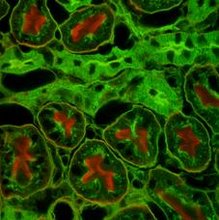
Principle:
Restriction enzyme activity:
Bacteria are under constant attack by bacteriophages. To protect themselves, many types of bacteria have developed defence mechanism in the form of enzymes called endonucleases that chop up any foreign DNA. Since these enzymes restrict the infection of bacteriophages they are termed “restriction endonucleases”. These molecular scissors found in the bacterial cytoplasm can prove dangerous to the cell, so bacteria protect their own DNA by methylating the adenine or cytosine bases. The methyl groups block the binding of restriction enzymes, but not the normal reading and replication of genetic information. DNA from attacking bacteriophages will not have these protective methyl groups and will be destroyed.
Together restriction enzyme and its modification methyltransferase form a restriction modification (RM) system. Four kinds of RM systems are known. These are distinguished based on subunit composition, kinds of sequences recognized and cofactors needed for activity. Most characterized enzymes (about 93%) belong to type II class. they comprise the commercially available restriction enzymes used for DNA analysis and other manipulations.
Restriction enzymes are powerful tools of molecular genetics used to:
Map DNA molecules
Analyze population polymorphisms
Rearrange DNA molecules
Prepare molecular probes
Create mutants
The type II restriction enzymes recognize specific DNA sequences and cleave the DNA at fixed locations at or near the recognition sites. They act as dimmers, each subunit recognizing the 5”-3” nucleotide sequence in complementary DNA strands and hence are said to recognize palindromic sequences. Before the restriction enzyme cuts at its specific recognition site on a long DNA, it binds to a site amidst a very large number of non-cognate sites. This protein is then translocated from the initial site to specific site, which occurs by “jumping or sliding”. At this recognition site in presence of Mg+2, enzyme undergoes a conformational change, which kinks the helix and cleaves the DNA producing blunt or sticky ends.
Procedure:
Setting up the restriction digestion reaction
1. Place the vials containing restriction enzyme (EcoR I and Hind III) on ice.
2. Thaw the vials containing substrate (lambda DNA) and assay buffer.
3. Prepare two different reaction mixtures using the following constituents.
Reaction 1 (EcoR I digestion)
· L DNA 20ul
· 2x assay buffer 25ul
· EcoR I 3ul
Reaction 2 (Hind III digestion)
· L DNA 20ul
· 2x assay buffer 25ul
· Hind III 3ul
2. Incubate the vial at 37oc for 1 hour.
3. Meanwhile, prepare a 1% agarose gel for electrophoresis.
4. After an hour add 5ul of gel loading buffer to vials
5. Load the digested samples, 10ul of control DNA and 10ul of marker, note down the order of loading.
6. Electrophorase the samples at 50-100 V for 1-2 hrs.
7. Stain the agarose gel with 1X staining dye.
8. Destain to visualize the DNA bands.
Restriction enzyme activity:
Bacteria are under constant attack by bacteriophages. To protect themselves, many types of bacteria have developed defence mechanism in the form of enzymes called endonucleases that chop up any foreign DNA. Since these enzymes restrict the infection of bacteriophages they are termed “restriction endonucleases”. These molecular scissors found in the bacterial cytoplasm can prove dangerous to the cell, so bacteria protect their own DNA by methylating the adenine or cytosine bases. The methyl groups block the binding of restriction enzymes, but not the normal reading and replication of genetic information. DNA from attacking bacteriophages will not have these protective methyl groups and will be destroyed.
Together restriction enzyme and its modification methyltransferase form a restriction modification (RM) system. Four kinds of RM systems are known. These are distinguished based on subunit composition, kinds of sequences recognized and cofactors needed for activity. Most characterized enzymes (about 93%) belong to type II class. they comprise the commercially available restriction enzymes used for DNA analysis and other manipulations.
Restriction enzymes are powerful tools of molecular genetics used to:
Map DNA molecules
Analyze population polymorphisms
Rearrange DNA molecules
Prepare molecular probes
Create mutants
The type II restriction enzymes recognize specific DNA sequences and cleave the DNA at fixed locations at or near the recognition sites. They act as dimmers, each subunit recognizing the 5”-3” nucleotide sequence in complementary DNA strands and hence are said to recognize palindromic sequences. Before the restriction enzyme cuts at its specific recognition site on a long DNA, it binds to a site amidst a very large number of non-cognate sites. This protein is then translocated from the initial site to specific site, which occurs by “jumping or sliding”. At this recognition site in presence of Mg+2, enzyme undergoes a conformational change, which kinks the helix and cleaves the DNA producing blunt or sticky ends.
Procedure:
Setting up the restriction digestion reaction
1. Place the vials containing restriction enzyme (EcoR I and Hind III) on ice.
2. Thaw the vials containing substrate (lambda DNA) and assay buffer.
3. Prepare two different reaction mixtures using the following constituents.
Reaction 1 (EcoR I digestion)
· L DNA 20ul
· 2x assay buffer 25ul
· EcoR I 3ul
Reaction 2 (Hind III digestion)
· L DNA 20ul
· 2x assay buffer 25ul
· Hind III 3ul
2. Incubate the vial at 37oc for 1 hour.
3. Meanwhile, prepare a 1% agarose gel for electrophoresis.
4. After an hour add 5ul of gel loading buffer to vials
5. Load the digested samples, 10ul of control DNA and 10ul of marker, note down the order of loading.
6. Electrophorase the samples at 50-100 V for 1-2 hrs.
7. Stain the agarose gel with 1X staining dye.
8. Destain to visualize the DNA bands.


No comments:
Post a Comment